Watermelons are one of the most satisfying fruits to grow at home. Their refreshing sweetness and hydrating pulp make them a garden favorite during the warmer months. If you’re ready to cultivate your own juicy harvest, this guide to growing watermelons from seeds will help you get started—from selecting the right soil and sunlight conditions to proven growing tips.

Why Grow Watermelons from Seeds?
Starting watermelons from seeds allows for greater variety selection, better root development, and more organic control. Many gardeners choose to grow from seed to enjoy heirloom or specialty varieties not typically available as seedlings.
Best Time to Plant Watermelon Seeds
Watermelons are warm-season crops. The ideal time to plant watermelon seeds is in late spring or early summer, once the soil temperature is consistently above 21°C (70°F). They are highly sensitive to cold and frost.
-
In warm regions: Sow seeds outdoors directly in the soil.
-
In cooler climates: Start seeds indoors 3–4 weeks before transplanting outside.
Soil Requirements for Watermelons
Watermelons thrive in well-drained, sandy or loamy soil rich in organic matter.
-
Soil pH: Between 6.0 and 6.8 is ideal.
-
Preparation: Mix compost or well-rotted manure into the soil before planting.
-
Drainage: Avoid waterlogged soils—raised beds or mounded rows help improve drainage.
Tip: Adding mulch around your watermelon plants conserves moisture, suppresses weeds, and keeps the fruit clean.

Sunlight Needs
Watermelons require full sun to develop their large fruits and sweet flavor.
-
Provide at least 8 hours of direct sunlight each day.
-
Choose an open area free from shading trees, fences, or tall crops.
Proper sunlight exposure helps with photosynthesis, disease resistance, and fruit development.
How to Grow Watermelons from Seeds
1. Sow Seeds
-
Directly sow watermelon seeds 1 inch deep into the soil.
-
Space seeds 2 to 3 feet apart, depending on the variety.
-
Plant in rows spaced 5–6 feet apart to allow for vine growth.
2. Watering
-
Keep the soil consistently moist but not soggy during early growth.
-
Reduce watering once fruits start forming to concentrate sugars.
3. Fertilization
-
Use a balanced organic fertilizer or compost tea every 2–3 weeks.
-
Avoid high-nitrogen fertilizers after flowering, as they promote leaf growth over fruit.
4. Pollination
Watermelons need pollination to set fruit. Bees and other pollinators play a crucial role, so avoid pesticides and plant pollinator-friendly flowers nearby.

Common Growing Tips
-
Support vines by spacing them adequately; avoid crowding.
-
Use black plastic mulch to warm the soil and encourage early growth.
-
Watch for pests like aphids, cucumber beetles, and squash bugs.
-
Harvest when the tendril nearest the fruit turns brown and the underside of the melon is creamy yellow.
Final Thoughts
Growing watermelons from seeds is an incredibly rewarding part of organic gardening. With the right soil, sunlight, and care, you’ll be enjoying homegrown melons bursting with sweetness. Whether you prefer classic varieties or smaller, container-friendly types, starting from seed offers flexibility and freshness straight from your own garden.
Explore high-quality watermelon seeds at PureAsiaSeeds.com and begin your summer harvest journey today.








